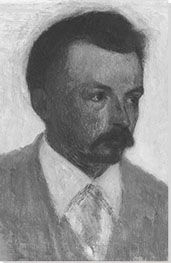Summary of Vilhelm Hammershøi
In the quiet interiors, bare exteriors, and sparse landscapes of Vilhelm Hammershøi an impenetrable riddle is concealed. He is best known for his paintings of domestic spaces, scantly furnished rooms with white walls and plain floors: horizontal and vertical planes that often meet at irregular points on the canvas. Figures sit or stand, turned away or half-concealed, perhaps engrossed in an activity such as reading which draws their attention away from us. Like the sitter to the book, our perception is somehow irresistibly drawn to these spaces, in which almost nothing is happening, but which suggest something profound and inexpressible about the nature of life and art. The bare facades, skies, streets and tree-lines of his outdoor scenes have the same effect. The most immediate point of reference for Hammershøi's work is Symbolism, and we can also trace a thread of affinity back through the Naturalist and Realist traditions of Northern Europe to the Dutch Golden Age. But in effect, Hammershøi's work stands, like one of his models, in an imaginative space of its own creation.
Accomplishments
- Hammershøi was amongst the most understated of late-nineteenth-century avant-garde artists, avoiding both the ostentatious formal transgression of French Post-Impressionist groupings and the decadent exoticism of his Symbolist contemporaries. Instead, he allowed the strangeness of his compositional arrangements - often based around asymmetrical intersections of floor and wall - and the daring minimalism of his subject-matter, to impress themselves with a quiet intensity, drawing the viewer away from everyday perception with a gradual but ineluctable force.
- Hammershøi became famous as a painter of domestic spaces, but he was, more exactly, a painter of architecture and design, both interior and exterior. His indoor scenes are populated with distracted and concentrated figures, while his cityscapes are bereft of human inhabitants altogether, the streets and buildings taking on a power and life of their own. Such was the clarity and uniqueness of his vision for these spaces - beautiful, quiet, mysterious - that his influence has been felt in architecture and cinematography as much as in modern painting.
- Though Hammershøi might be described as a Symbolist, he was an atypical one. Whereas his contemporary Fernand Khnopff - perhaps Hammershøi's most obvious kindred spirit in that wider movement - often turned to explicitly uncanny or supernatural motifs to indicate the world of dream and myth lying behind the everyday, none of Hammershøi's symbols lie outside the realm of the imaginable. The reading figure; the canvas turned to the wall; the door ajar, leading into an empty room: his symbolic lexicon was composed of familiar objects and postures, making their capacity to express the deep, unyielding enigmas of life all the more extraordinary.
Important Art by Vilhelm Hammershøi
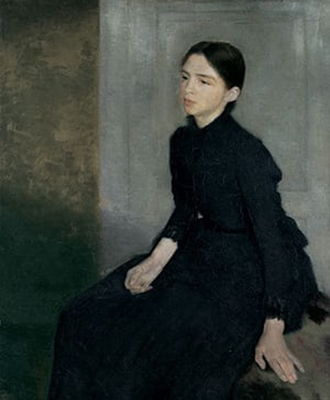
Portrait of a Young Woman. The Artist's Sister Anna Hammershøi
This portrait of Hammershøi's younger sister Anna was created when the artist was just 21 years old. It might seem a somewhat unremarkable work, depicting a young woman with a faintly distracted expression wearing a black dress and set against a neutral background. But in its very informality and lack of ceremonial significance - its truth to life - it reflected some of the paradigms of Naturalist and Realist portraiture popular in Europe and Russia at the time. At the same time, it also introduces the subtle allusiveness that would set Hammershøi's work apart from those genres, shifting the composition into a space of dreamlike intensity.
In compositional terms, the informal arrangement of the interior, and the capturing of the sitter in an apparently momentary posture, brings to mind the newly incidental quality that photography had suggested to painting - the work seems almost like a snapshot of a passing moment. Her hands are oddly arranged: one sits curled on her lap, the other placed lightly on the surface, on which she perches at an odd-angle away. Perhaps partly because of this quality of ephemerality, the young woman seems somewhat unknowable: her expression is inscrutable, as she looks off into the distance.
The painting caught people's attention at the time precisely because of its lack of detail: it did not give away any details of the sitter's class, occupation, or character. All the drama and intrigue of the painting seems to lie in questioning the internal thought process rather than reading the explicit cues of composition and style. In opening out the meaning of the work to the viewer, it established Hammershøi as a subtly avant-garde painter, who exposed news ways of suggesting meaning through representative art.
Oil on canvas - The Hirschsprung Collection, Copenhagen
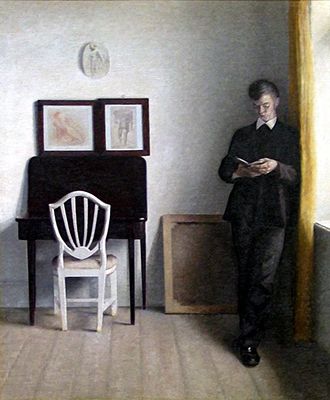
Interior with Young Man Reading
In this painting, Hammershøi depicts his older brother Svend reading in the artist's apartment on Åboulevarden in Copenhagen. The arrangement of the work is particularly striking, each object depicted contributing something to the mood of quiet calm, and suggesting the wholly incidental nature of the scene. The young man stands by the window, as if to catch the light, his chair pushed against the desk unused; an incomplete or discarded canvas appears to rest behind him, facing the wall, as if it were a metaphor for the untold secrets of the scene itself. In his focused state, the young man seems oblivious to what is going on around him, so that it appears that the painter's presence is entirely undetected by the sitter.
In this painting, Hammershøi establishes a key theme in his work of absorption: it seems that by making reading a central focus of his painting, Hammershøi was often inviting his viewers to enter the same place of quiet contemplative engagement of his sitters. By all accounts, this was a space that the artist himself readily inhabited; contemporaries all remarked on a polite but withdrawn, even odd manner, that seems to pervade the character of his work.
But Hammershøi was not a wholly withdrawn or unworldly figure; the misty, almost monochromatic quality of color in this work, and the subtle dappling of paint on the wall, not only render a secretive mood but also allude to contemporary Impressionists such as Monet and Whistler (the latter of whom Hammershøi revered). The arrangement of the canvas into non-symmetrical intersecting planes - so that most of the picture-space is taken up by the wall behind, with thinner strips representing window and floor to the right and below - is also characteristic of his work, and also subtly radical. It predicts the geometric abstraction of early-twentieth-century Cubist and Constructivist painters, suggesting an artist as preoccupied with the arrangement of lines on a canvas as with the representation of a space beyond it.
Oil on canvas - The Hirschsprung Collection, Copenhagen
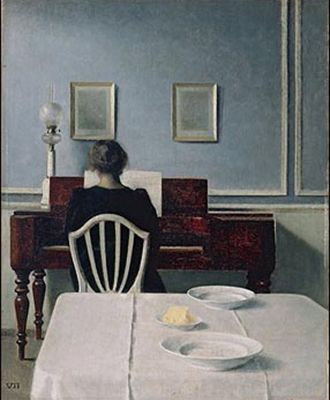
Interior with Woman at Piano, Strandgade 30
In this well-known work from 1901, Hammershøi's wife Ida sits with her back to the viewer in front of a piano. In the foreground is a table covered in a crisp white cloth, on which stand three plates, two empty and one full of butter. Though the woman is 'at' the piano, her lowered arms suggest that she is not playing it; she is more likely to be reading the score perched on the stand. Both the score and the paintings that hang above her head, however, are blurred and indistinct, as if, like the discarded canvas behind Svend, they are withholding their secrets from us. Likewise, any sensuous pleasure that might be implied by the meal-table is lacking because of the empty plates. Only the butter has been brought through, and stands as "a vivid marker", as the critic Bridget Alsdorf puts it, "of the sensual appetites otherwise hidden in Hammershøi's rooms."
The hidden face, obscured scores and canvases, and empty plates suggest a small but insoluble enigma at the heart of this painting: there is a fundamental mystery to lived experience, perhaps, that art can never hope to penetrate. In conveying this message, the work could be described as Symbolist in tone. At the same time, the arrangement suggests a number of deeper historical sources. Hammershøi's love of Vermeer is well-documented, and compositions such as The Music Lesson (1662-65) and The Art of Painting (1665-68) comprise a similar set of compositional ingredients. Like this work, moreover, Vermeer's domestic genre pieces are also artworks focused on the act of artistic creation.
For Alsdorf, this painting "epitomizes the fundamental tension of Hammershøi's interiors between the austere routine of everyday life, as he conceived it, and the sensuous pleasure and psychological absorption of art." This tension is both one that consumes the sitter and one that we as viewers are invited to partake in; just like brother Svend then, Ida secures our empathy even as she withholds her feelings and intentions.
Oil on canvas - Private Collection
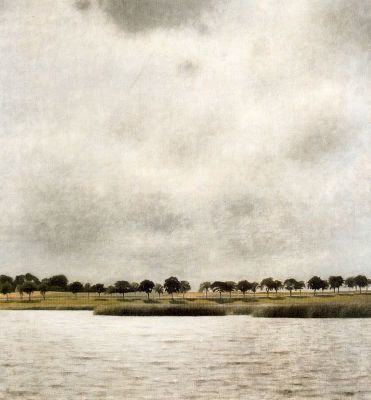
A View of Gentofte Lake ("The Sunshower")
Though he was primarily a painter of architectural spaces, Hammershøi also produced a significant body of work depicting the natural landscapes of his native Zealand, the island containing Copenhagen. These works tease the same otherworldly presence from their depopulated subject-matter as the cityscapes he was also beginning to produce with increasing regularity by the start of the 1900s. In this painting, the uninterrupted regularity of the horizontal stripes and blocks which fill the canvas give the landscape that uncanny, almost supernatural quality that comes from near-symmetry in nature, while at the same time pre-empting the advances of abstract landscape painting in the decades to come.
There is also a biographical narrative behind this image of Gentofte Lake, an area now incorporated into the suburbs of Copenhagen but which was, at the turn of the twentieth century, still located in the countryside to the immediate north. This was a summer vacation spot for the Hammershøis, and, as such, this scene would have held something of the eerie pull of the familiar recognizable from his interior scenes. The absence of people is perhaps more expected in such an image than in later works depicting the facades of grand Neoclassical buildings from obscure angles, but nonetheless, this painting suggests that same sense of invisible presence or otherworldly life which is the hallmark of Hammershøi's outdoor paintings. This is perhaps an effect of the way the trees align themselves like intelligent beings, as if they were human figures or animals massed on the far shore.
The submerged influence of the Skagen Group painters, particularly Hammershøi's old mentor P.S. Krøyer, seems particularly obvious from the younger artist's landscapes. While a work such as Krøyer's Summer Evening on Skagen's Southern Beach (1893) presents an empty shoreline as the setting for an idyllic country stroll, and as an excuse to celebrate the famous north Jutland light, we can see works like A View of Gentofte Lake partly as obscure homage to the life-affirming Naturalism of the Skagen group.
Oil on canvas - Private Collection
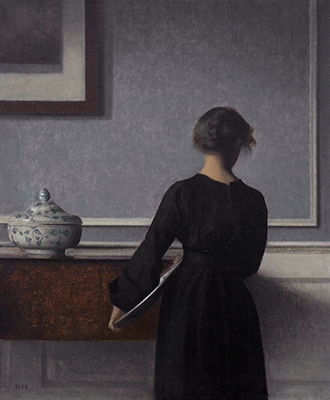
Interior with Young Woman Seen from the Back
This painting is probably Hammershøi's best-known and most replicated work. Again, the artist uses his wife Ida as a model. She stands turned away from us, with her head slightly bowed, as if she were looking at an object lying slightly below the frame. Behind her is a wooden sideboard on which sits a ceramic pot, an object that reappears in several other of Hammershøi's paintings.
Though Hammershøi's significance to late-nineteenth-century painting is well-documented, it is perhaps less frequently noted that he also contributed to a new paradigm in Scandinavian interior design. In the simplicity of this space's arrangement - the single ornament lying on the sideboard, the wall free from cornicing or ornament - we can sense Hammershøi's rejection of the cluttered aesthetic of the nineteenth-century bourgeois home, and also his distance from the Art Nouveau aesthetic of the fin-de-siècle. In his quest for a spartan domestic beauty he was not alone: along with the painters Carl Holsøe and Peter Ilsted - the latter his brother-in-law - he captured in paint a new approach to domestic design emphasising the uncluttered arrangement of objects, and a palette of muted greys and whites. The three painters became known as the Copenhagen Interior School, and the striking similarities between their work - seeing any of Holsøe and Ilsted's 'interiors' - certainly implies a collective aesthetic.
As the writer and art historian Poul Vad comments, "[i]n his interior decoration Hammershøi strove for simplicity bordering on the ascetic, exquisite aesthetically but nonetheless unassuming and with a quality of anonymity, and precisely therefore it appears as a strongly defined individuality." Ultimately, it was the individuality of spirit with which these apparently anonymous spaces were infused that ensured Hammershøi's reputation.
Oil on canvas - Randers Museum of Art, Denmark
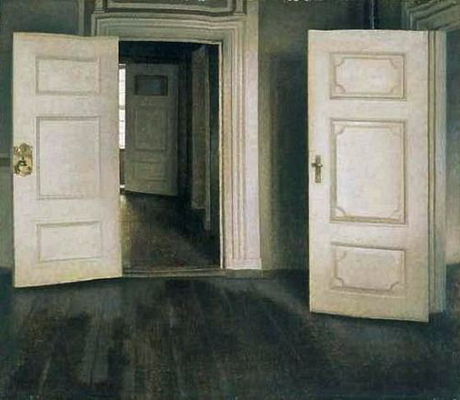
White Doors
At first sight, this might appear to be a painting lacking a subject-matter, but its unassuming - not to say non-existent - theme belies its narrative daring and complexity, and Hammershøi's acute sense of composition. Placing the viewer in the back-left corner of an empty room, he allows us to catch glimpses of the two rooms that lie beyond - the second containing a far-off light source which cuts a soft diagonal line across the canvas - and another lying closer, immediately to the right. Perhaps because of our strongly ingrained associations between domestic spaces and human habitation, these semi-concealed rooms practically throb with a sense of hidden presence or possibility, an effect which is at once enticing and curiously threatening. This is not the only work of Hammershøi's to include white doors; like the image of figure reading, they suggest a threshold between the space depicted and another lying out of sight and conceptual grasp. The door is a threshold, both literally and figuratively.
The most immediately arresting aspect of the composition, however, is perhaps the absence of people. In the lack of a human subject-matter, the domestic space itself takes on some of the enigmatic mystery of Hammershøi's models. Although the heritage of this work is in Naturalist genre-painting, another point of affinity is the more subtle and enigmatic images to emerge from the European Symbolist movement during the late nineteenth century. Hammershøi is often mentioned in the same breath as the Belgian painter Fernand Khnopff, and works like Khnopff's The Garden (1886) give some sense of the artistic precedent and context for pieces like White Doors (1905), in which familiar spaces are imbued with a disconcerting sense of otherness.
For the art critic Jonathan Jones, this painting "lets you glimpse a terrible nothingness through the rooms of an ordinary home". At the same time, and more positively, it might suggest the infinite possibilities that any space can contain. It implies the capacity of the everyday to surprise us: even when we think we know a subject-matter inside out, the artist has the capacity to defamiliarize it; present it to us afresh.
Oil on canvas - The David Collection, Copenhagen
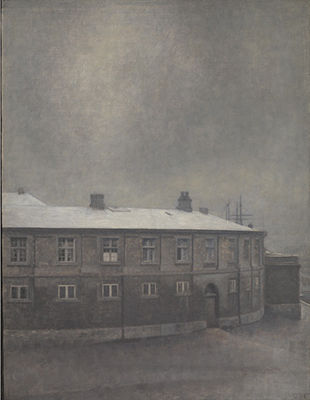
A Wing of Christiansborg Palace
Though Hammershøi's best-known works are of interiors, he also explored the exteriors of buildings, particularly towards the end of his life. Like all of Hammershøi's landscape paintings and cityscapes, this painting of a wing of Christiansborg Palace - a baroque structure built to house the Danish royal family and later various institutions of government - is devoid of human occupants, the barren walls and walkways taking on a subtle and uncanny life of their own.
In this late work, the color-palette is almost completely greyscale, which might remind us of earlier grisaille paintings undertaken by Flemish masters such as Jan Van Eyck and Pieter Bruegel the Elder. However, unlike those paintings, which used that color-scheme to suggest the shape and texture of sculpture, Hammershøi seems to use the color-palette to suggest the peculiar uniformity of color in the scene itself. Though he paints the façade with some level of detail, he seems to prioritise the intimate play of light over the exact detailing of each part of the building. In the painting's slight fuzziness, it appears as if we look at it through fog or cloud, as if the building is very far from us. The effect is to blur our perception so that reality appears slightly unreal, an effect enhanced by the complete absence of human activity.
As the Jonathan Jones puts it, "Hammershøi's surfaces are dusty [...] The light does not glow, it congeals". It is possible to speculate on the influence of Hammershøi's multiple trips to London on his later city-scenes. Certainly, London-based artists at this time such as Walter Sickert, Spencer Gore - both associated with the Camden Town School - were producing similarly moody, dusky scenes of streets and buildings, and Hammershøi's love of that great painter of the London night James Abbott McNeill Whistler is well-established.
Oil on canvas - National Gallery of Denmark, Copenhagen
Biography of Vilhelm Hammershøi
Childhood and Education
Vilhelm Hammershøi was born on the 15th of May, 1864 in Copenhagen, Denmark. The son of a well-off merchant, he was brought up with his sister and two brothers in a large house in the Old Quarter of Copenhagen, a city where he would remain for the rest of his life. Hammershøi showed artistic talent from an early age and was encouraged by his mother to begin training at the age of eight; his older brother Svend was also a painter. Vilhelm trained at the Royal Danish Academy of Fine Art between 1879 and 1884, taking lessons from the painter Niels Christian Kierkegaard, cousin of the famous philosopher Soren Kierkegaard. Hammershøi also worked with the Realist portraitist Frederik Vermehren, and thus was exposed from a young age to the great traditions of Danish painting. Vermehren himself had a place in that tradition, having been associated with the so-called Danish Golden Age of the early nineteenth century, when artists such as Christian Købke and Wilhelm Bendz depicted Romantic landscapes and interior spaces suffused with bright, clear light.
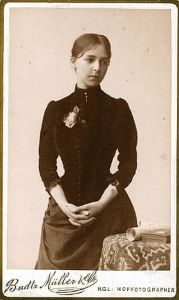
Hammershøi, whose own paintings are filled with a more subdued light, went on to study at the liberal Free School of Study for Artists, taking lessons from P.S. Krøyer between 1883 and 1885. Though Krøyer worked in a form of lyrical Naturalism - he was associated with the plein air painters of the Skagen group - he was keen to allow Hammershøi's talent to develop along its own lines. In a letter to a friend he remarked: "I have a student who paints quite strangely. I don't understand him, think that he will become prominent, will try not to influence him." In Spring 1885 Hammershøi submitted a portrait of his sister Anna to Copenhagen's annual Charlottenborg Exhibition. The work was controversial, as it rejected many of the tenets of Naturalism prevalent across Europe at the time, offering a more sombre, psychologically complex tone than had been expressed in recent Danish painting. Hammershøi was labelled by some as a 'neurasthenic', his works deemed to express the symptoms of nervous illness. Seemingly unperturbed, in 1887 he travelled to Holland, familiarising himself with the work of the Dutch Golden Age and, most significantly, with Johannes Vermeer, whose work would remain a crucial influence throughout the rest of his career.
Hammershøi submitted two more works, Young Girl Sewing and Bedroom, to the Charlottenborg Exhibition in 1891, but both were rejected. In response he, along with a number of other young artists, established Den Frie Udstilling, an independent salon along the lines of the Salon des Refusés in Paris which served as a forum for the expression of new and challenging artistic trends.
Mature Period
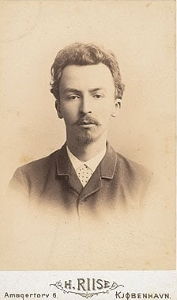
In 1891 Hammershøi married Ida Ilsted, who would become a much-used model in his work, particularly in the interiors for which he is now remembered. Ida also modelled for paintings by her brother Peter Ilsted who, like Hammershøi and the artist Carl Holsøe, was one of the key members of the so-called Copenhagen Interior School, known for their atmospheric domestic scenes.
After their marriage, Hammershøi and Ilsted spent six months in Paris, commencing a period of relatively frequent travel. Hammershøi made several other trips across Europe, including to Germany, Belgium and Italy. He also visited London on five separate occasions from 1897 onwards, at one point attempting unsuccessfully to visit his idol James Abbott McNeill Whistler. In 1905-06, he created two works depicting the façade of the British Museum, having turned more attention during the first few years of the twentieth century to exterior urban architecture. It is possible to speculate on the influence on this work of various artists whose work Hammershøi might have encountered first-hand during his travels, including the Camden Town Group.
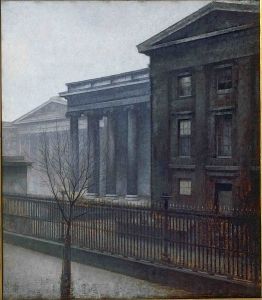
However, the details of Hammershøi's biography remain as scant as the interiors of his rooms. What is known is that much of his and Ida's life together was spent in two apartments a few doors away from each other in the Christianshavn district of Copenhagen: first Strandgade 30 between 1899 and 1909, then Strandgade 25 between 1913 and 1916. These apartments are the primary settings for Hammershøi's most famous paintings, and the muted color-scheme and hue of the works directly reflects the couple's designs for the apartments, which were painted in whites and pale greys. The layout of objects in these paintings reflects - and helped to contribute to - a new decorative style in Denmark at the time, distinctly more minimalist than the opulent fashions of the fin-de-siècle period in other countries.
By all accounts, Hammershøi was a quiet man, without many friends. However, he was said to have had many creative admirers, including the poet Rainer Maria Rilke, who noted that "[h]is work is long and slow and at whatever moment [one] comes to grips with it, one will have ample occasion to speak of what is significant and essential in art." Hammershøi was supported and mentored by the art collector Alfred Bramsen, who bought his first painting by the artist in 1898, and would publish a biography of him two years after his death.
Later years
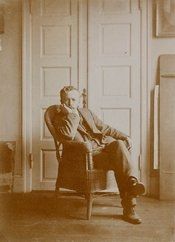
Although it is thought that Hammershøi kept diaries and personal letters throughout his life, many of these were burnt, so we do not have a huge store to draw from when speculating on his personal life. In a rare interview given in 1907, he spoke of the interest that interior spaces held for him: "I have always felt that such rooms possess great beauty even if there are no people in it; or perhaps precisely when there are none."
After several months in hospital, Hammershøi died of throat cancer in 1916. He was only 51 years old. The last painting he completed showed his wife sewing in the apartment they shared together. A memorial exhibition was held for him at the Copenhagen Kunstforeningen later that year.
The Legacy of Vilhelm Hammershøi
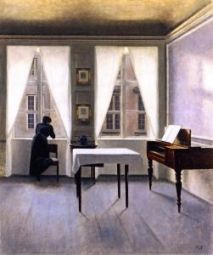
Though Hammershøi is now well-known as "the painter of tranquil rooms", it was only after a breakthrough exhibition in 1982 that he became celebrated outside his native Scandinavia. That show, Northern Light: Realism and Symbolism in Scandinavian Painting, 1880-1910, was curated by the art historian and critic Kirk Varnedoe, and held at the Brooklyn Museum in New York. It introduced the world to a range of little-known works, picking out an alternative narrative of European modern art to the familiar story of Impressionism and its offshoots. Hammershøi's informal arrangements of people and objects, full of mystery and melancholy, formed a central pillar of the show, throwing his work into a perhaps unlikely spotlight.
Hammershøi's influence can be felt across a significant roster of modern and contemporary painters' work. The pregnant atmospherics of his interiors might seem to predict the more exaggerated emotive genre painting of Northern European Expressionism, while, although his work is not easily related to the most iconoclastic strands in early-twentieth-century avant-garde art, it can be compared to the allusive object-based painting of Italian Metaphysical artists such as Giorgio Morandi. Hammershøi's influence can also be sensed in American Realist and Regionalist painting, most obviously the oeuvre of Edward Hopper, and later the work of Andrew Wyeth. In Hopper's lonely interiors, and in the arrangement of his figures - often pictured alone, or from a distance so that the face is obscured - we can catch an echo of Hammershøi's lithe portraiture.
Hammershøi's aesthetic legacy is not limited to painting, moreover, but can also be crucially linked to film. In Ingmar Bergman's Cries and Whispers (1972), several shots of corridors and rooms replicate the unusual perspectives of Hammershøi's work. More recently, the 2016 film The Danish Girl used Hammershøi's paintings as inspiration for the early part of the film set in Copenhagen. The set-designer for the film noted that the team wanted to recreate the artist's cool color-palette and minimalist aesthetic in order to communicate the new interior design principals popular at that time.
Influences and Connections

-
![Johannes Vermeer]() Johannes Vermeer
Johannes Vermeer -
![Rembrandt van Rijn]() Rembrandt van Rijn
Rembrandt van Rijn -
![James Whistler]() James Whistler
James Whistler - Christian Købke
- Fernand Khnopff
- Frederik Vermehren
- Karl Madsen
- P.S. Krøyer
- Carl Holsøe
- Peter Ilsted
-
![Giorgio Morandi]() Giorgio Morandi
Giorgio Morandi -
![Edward Hopper]() Edward Hopper
Edward Hopper -
![Andrew Wyeth]() Andrew Wyeth
Andrew Wyeth -
![Gerhard Richter]() Gerhard Richter
Gerhard Richter - Jens Ferdinand Willumsen
- Carl Holsøe
- Peter Ilsted
-
![Expressionism]() Expressionism
Expressionism -
![Realism]() Realism
Realism -
![Metaphysical Painting]() Metaphysical Painting
Metaphysical Painting - Copenhagen Interior School
